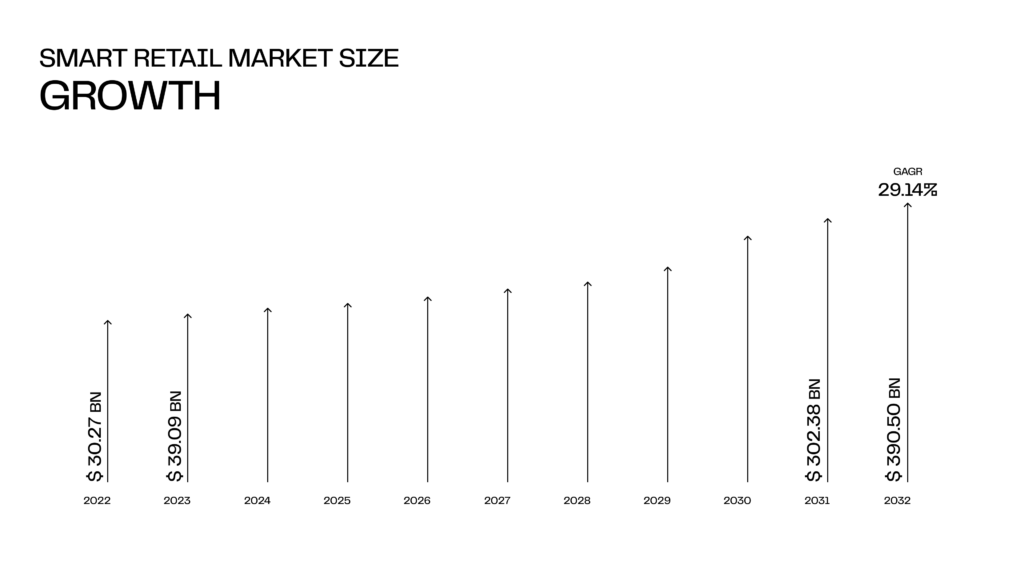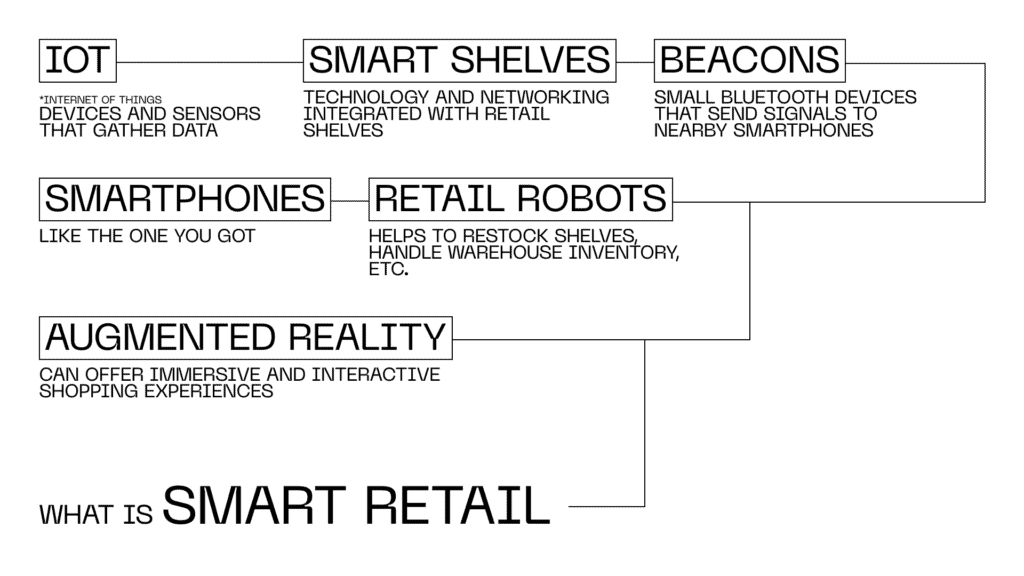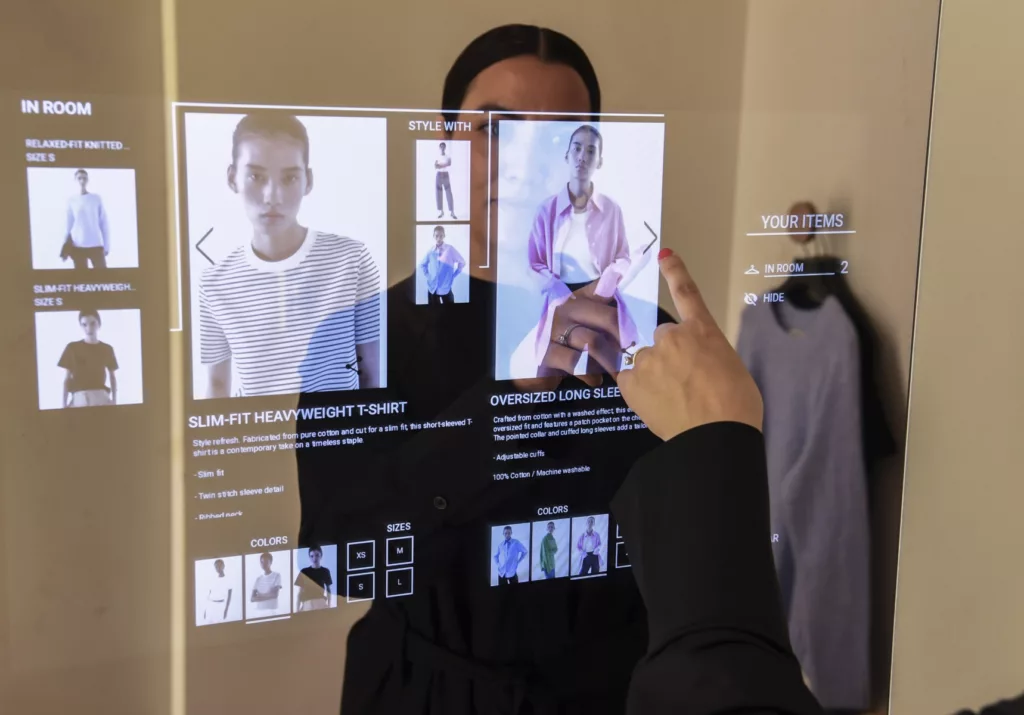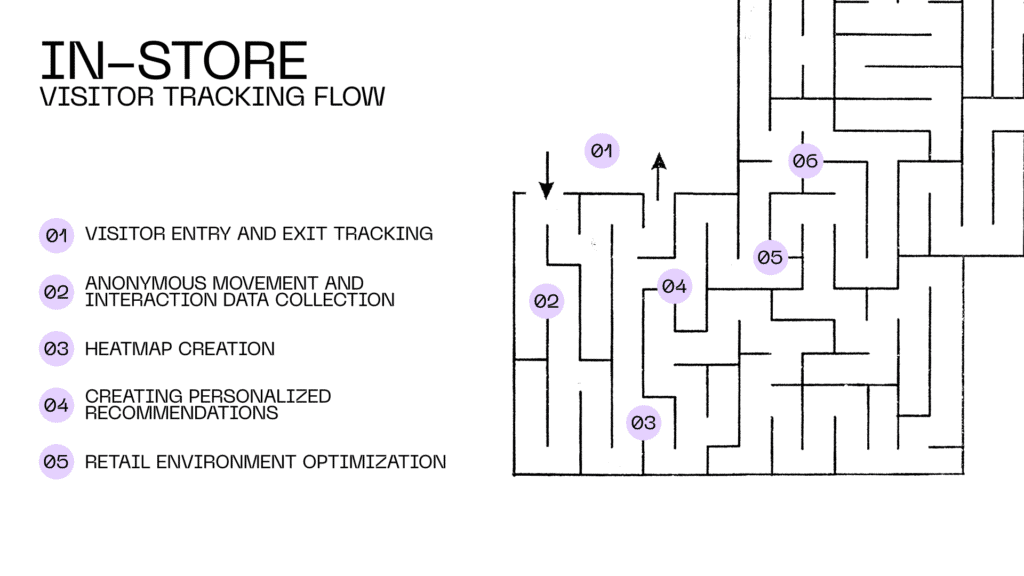If you’re still hesitant about investing in smart retail technologies, you’ve missed out on the advantages of being a first mover. However, there is a benefit to this situation. You get to skip the time-consuming process of testing potentially faulty hypotheses and directly implement the best practices.
Today, you’ll learn about the current smart retail technologies available in the market, their use cases, and the challenges they present. Additionally, you’ll receive advice on how to best approach the development of smart retail solutions to cut operational costs and increase profits.

What is smart retail?
Smart retail involves integrating advanced technologies and data-driven solutions into traditional retail stores. This integration enhances customers’ overall shopping experience, optimizes operations, and improves business outcomes.
The key elements and technologies commonly associated with smart retail include:
Internet of Things (IoT)
IoT devices and sensors can be integrated into shelves, products, shopping carts, and even the store itself to gather real-time data from the physical store environment. The collected data may be used for monitoring inventory levels, customer movement tracking, and shopping patterns analysis.
Mobile applications
Using mobile devices, customers can access personalized offers, promotions, and recommendations while they shop. Mobile payment options and contactless technology are also standard in smart retail environments.
Beacon technology
Beacons are small Bluetooth devices that send signals to nearby smartphones. They can be placed around the store to push location-based notifications, offers, and information to customers’ mobile devices.
For example:
- Target’s store app guides customers to the location of items on their shopping list;
- Nordstrom’s mobile app sends beacon-enabled notifications to inform customers when items in their shopping cart are available in the store they are passing by;
- CVS Health uses beacon technology to send real-time service notifications, such as reminders to refill or pick up a prescription, when customers enter a pharmacy.
Artificial Intelligence and Machine Learning
AI in smart retail can analyze collected data to gain insights into customer behavior and preferences. This information can be used to personalize marketing efforts, improve inventory management, and optimize pricing strategies.
For instance:
- Amazon uses AI and ML to provide highly relevant product suggestions and increase purchase likelihood;
- Netflix employs machine learning algorithms to recommend shows and movies users might enjoy based on their viewing history;
- Spotify uses ML and AI to curate personalized playlists and suggest new music based on a user’s listening history and preferences;
- Google leverages AI and ML technologies to deliver personalized search results and advertisements.
Augmented Reality and Virtual Reality
AR and VR can offer immersive and interactive shopping experiences. For example, customers can virtually try on clothes, visualize furniture in their homes, or see how makeup products look on their faces.
Examples of companies using AR and VR include:
- IKEA Kreativ, which enables customers to visualize items within actual rooms;
- Toyota’s AR app, which allows customers to visualize accessories on a physical vehicle;
- Walmart‘s use of Strivr, a VR training program for employee training in customer service, sales techniques, and store management.
Big Data
Big data tools help process and analyze vast amounts of data from various sources, optimize inventory management, and make data-driven decisions. For example:
- Walmart employs advanced big data analytics to predict product demand in different locations;
- JPMorgan Chase uses big data to prevent fraudulent transactions;
- Target relies on big data analytics to optimize dynamic pricing strategies;
- Apple uses sentiment analysis enabled by big data technologies to enhance their products and services and improve customer satisfaction levels.
Robotics and automation
These technologies can help with various tasks such as restocking shelves, handling warehouse inventory, and assisting customers with basic inquiries.
Amazon is renowned for its robotics and automation efforts. The company’s Proteus, Cardinal, and Sparrow systems showcase the success of ongoing testing and new approaches to inventory management and order fulfillment.
Blockchain
Blockchain technology is used in retail to create smart tags that reliably and safely track the authenticity and origin of products, preventing counterfeiting.
In food retail, blockchain helps prevent food spoilage and ensure compliance with government food regulations. To do this, the technology is paired with IoT devices to monitor storage conditions and send alerts if they do not meet set values.
Finally, blockchain enables a decentralized approach to loyalty programs. It allows different brands to partner in a loyalty network where customers can earn and use points across partners while maintaining their privacy.
Usage examples include:
- Walmart DL Freight, a blockchain network that serves as a single source of truth for all supply chain participants;
- Tracr by De Beers, a platform that traces a product’s (diamond’s) journey through the supply chain;
- American Express’s rewards program, which leverages blockchain technology to allow merchants to tie American Express reward points to their own products;
- Carrefour‘s use of blockchain-based tracking for products.

Benefits of smart retail technology
Smart store solutions enable businesses to improve retail operations and enhance customer shopping experience. It is possible due to the advantages the smart retail technology has over traditional tools, the key ones being:
- Precise customer data collection. Intelligent tools operate in real-time, capturing customer data as it happens and logging it in automatically. This results in more comprehensive data collection and minimizes inaccuracies that tend to happen when using paper surveys or manual data entry.
- Simplified decision-making. Smart retail systems can automate data analysis, identify patterns in consumer behavior, and make predictions. This decreases the workload on an employee and leaves them more time for strategizing and planning.
- Increased traffic and income. Marketers can create more relevant campaigns by better understanding customer preferences, leading to higher conversion rates and customer loyalty. Besides, heat mapping and footfall tracking tools can provide insights into customer behavior within the store and help optimize layouts, product placements, and visual merchandising to increase sales.
- Optimized inventory management. Real-time inventory tracking and data analytics help retailers avoid stockouts by replenishing products at the right time, reducing overstocking and holding costs, and improving inventory turnover.
- Streamlined supply chain management. Smart technologies enable better communication and collaboration between suppliers, manufacturers, and retailers. This results in faster order fulfillment, reduced lead times, and, ultimately, enhanced customer satisfaction.
- Efficient checkout process. Self-checkout options and contactless payment methods speed up the checkout process, reducing customer wait times and improving overall store efficiency.
- Enhanced security and loss prevention. AI-powered surveillance cameras and RFID tags help prevent theft and shrinkage, reducing losses and ensuring a safer shopping environment for customers and staff.
Want to boost your retail store’s profitability?
Syndicode’s custom development services can help. Check out our recent solution for a retail store.
Explore nowUse cases of smart retail tech implementations
1. Smart mirrors
H&M implemented smart mirrors in its fitting rooms as a part of its tech-enabled shopping strategy. This AI-powered technology recognizes products in the room and offers personalized styling recommendations. Customers can also review the item in other available sizes and colors, request additional items without leaving the fitting room, and purchase directly from the mirror.
The expected benefits include an enhanced customer experience through frictionless checkout, more sustainable delivery and return options, and improved business efficiency by better understanding the demand for specific products.
Amazon is another well-known retailer planning to introduce smart mirrors within its Amazon Style framework, allowing customers to review and shop across environments and devices.
2. Virtual fitting rooms
Walmart’s Choose My Model feature uses AI and computer vision to allow online shoppers to estimate how a specific item will look on them. Customers can select the most suitable fit by reviewing different models with similar body types. The retailer reports a strong positive response from customers regarding this feature.
Other famous brands, including Amazon, with its Virtual Try-On for Shoes feature, Nike, Adidas, and Zalando, also use virtual fitting technology. However, these companies (except Zalando) overlay digital images of items on the user’s body parts instead of using a model. This is made possible by leveraging the capabilities of augmented reality and mobile devices.

3. Smart shelves
Also known as digital shelves, these AI-powered display stripes replace traditional paper price tags. They can dynamically display prices, promotions, advertisements, and more.
Kroger Co., one of the largest supermarket chains in the US, installed smart shelves with NFC tags, allowing users of the Kroger mobile app to identify items from their grocery list on the shelves quickly.
This solution gained much traction and substantially improved the organization’s efficiency and effectiveness.
4. Retail robots
In brick-and-mortar stores, robots are handy for performing monotonous tasks like cleaning and inventory management. Walmart introduced automated floor scrubbers and shelf scanners in its stores to save employees time and improve efficiency.
But robots can also perform social tasks, such as providing information or entertaining customers. Softbank’s humanoid robot Pepper has been successfully working in stores across the USA and Japan, providing directions, answering questions, and taking selfies with people. The company claims its clients saw a substantial increase in visitors and revenue shortly after “hiring” the robot.
5. Mobile POS
Mobile point-of-sale solutions enable merchants to process payments using a mobile device instead of a POS terminal or a cash register. This technology helps increase the payment speed and adds flexibility to the checkout process.
Many brands worldwide, including Gucci, Nike, and Radley, have successfully implemented mPOS systems in their smart stores.
6. Visitor tracking
Customer tracking technology allows retailers to collect data on customer movement within the store using WiFi hotspots and IoT systems. This data helps business owners identify areas of the shop that aren’t working as expected and tailor their layout, products, and advertisements accordingly.
When combined with CCTV imagery, visitor tracking tools provide insights into specific demographics and their behavior under various conditions—for example, understanding whether women tend to visit the seasonal aisle more often with children or without.
Walmart, a pioneer in adopting new technologies, has adopted visitor tracking systems to boost sales.

Challenges in implementing smart retail technologies
High upfront costs
The cost to build the infrastructure and train staff can be significant. The cost of a mobile app alone can start at $50K. When you add the purchase, installation, and setup of various IoT devices, surveillance systems, smart mirrors, and automation solutions, plus employee salaries, the total becomes substantial.
Solution: Don’t try to implement everything at once. Prioritize and integrate new technologies gradually. Test each new feature before fully investing in full-scale implementation to save costs and minimize risks. For example, starting with an MVP for a new software product is a smart move.
Overwhelmed by smart retail choices?
Syndicode will guide you to the best solution for your business.
Write usData processing and management
The vast amount of data requires specialized technical and analytical skills to derive relevant insights.
Solution: If you have trouble finding the right experts or need to quickly scale your team for a surge in work, using outsourcing services to hire dedicated specialists can be very helpful.
Lack of customer trust
Many technologies need certain conditions to work properly, requiring customers to be willing to share their data.
For instance, IoT-enabled tech requires customers to install the brand’s mobile app, create an account, and turn on their device’s Wi-Fi and Bluetooth. At the same time, people are concerned about potential privacy issues and often try to limit the amount of data they share.
Solution: Design technology interfaces to be user-friendly and intuitive to minimize the learning curve. Additionally, be transparent about data collection practices by explicitly telling customers how their data will be used, stored, and protected.
Engaging customers in testing and implementing new technologies can give them a sense of control and improve trust. Therefore, encourage active feedback to enhance the technology and establish robust customer support channels.
Don’t forget to clearly announce every step you take towards providing better customer service and explain how technology helps achieve that.
Practices to consider before investing in smart retail
Smart store technologies have revolutionized the retail sector, bridging the gap between physical stores and online shopping. Embracing these technologies presents businesses an opportunity to thrive by providing customers with precisely what they need right where they are.
However, implementing smart cameras, IoT devices, machine learning and AI, VR and AR, and other solutions involves a substantial investment. To help you make informed decisions and prioritize solutions that align with your business goals, we have prepared the following checklist:
1. Define objectives for implementing smart retail solutions
Planning is the first step in any endeavor. It provides direction and purpose, helps ensure alignment with business goals, and measures success.
First, identify the specific area you want to improve using smart retail solutions. Do you want to enhance personalization? Streamline checkout? Or maybe increase sales? Each of these goals requires a different approach.
Next, clearly define what you want the smart technology to achieve and decide how you will measure success. Then, check in with stakeholders and ensure the company has enough resources to implement the solution. Finally, estimate the time needed to implement the smart technology to control spending.
For example, if the goal is to reduce checkout times by 50%, you could introduce a mobile POS system. You can measure success by tracking the reduction in average checkout and customer wait times. This enhancement aligns with the company’s goals for the chosen period. With the current budget and team, the POS system can be implemented in six months.
2. Build on what you already have
In many cases, building on top of existing infrastructure is more cost-efficient and quicker than starting from scratch. For one, leveraging current infrastructure lowers the initial investment required for smart retail solutions.
It also reduces the amount of training needed, as employees are already familiar with the systems and processes, thus speeding up delivery.
Additionally, avoiding a complete system overhaul reduces the risk of service disruptions, as you can work incrementally.
So, as you plan the implementation of smart solutions, audit your current infrastructure. Identify integration points for smart solutions and create a phased implementation plan.
Don’t forget to assess the skills of your current staff and determine how you will address any skill gaps.
3. Find a skilled technology partner
A digital transformation services provider can offer best practices from various implementations across different industries, helping you optimize development and avoid common pitfalls.
Even if your in-house team handles most of the work for implementing smart retail solutions, having a technology partner who can provide extra hands will help ensure your project stays on schedule, even if unexpected issues arise.
Moreover, specialized software development companies offer access to advanced tools and technologies. These can accelerate development and simplify compliance with industry standards, but they are costly for an individual company.
Finally, a technology partner can provide support and maintenance services, freeing up your core team for business-critical tasks.
Syndicode: your partner in implementing smart retail solutions
Our development team excels in optimizing workflows and improving processes through custom solutions. We’ve handled numerous digital transformation projects across various industries, ensuring efficient, scalable, and user-friendly IT products.
One notable project involved automating order processing for ThredUP, a large retail platform. After collaborating with Syndicode, ThredUp successfully raised $168 million through its Initial Public Offering.
Another example is Le New Black, a fashion sales app. The Syndicode team equipped the app with a custom-built AI-based visual recognition module and other unique solutions, greatly enhancing the app’s UI and performance.
BookYaBike is another project where we delivered the marketplace from scratch, featuring an advanced pricing solution.
If you’re interested in learning more about these and other projects, please visit our featured projects page.
Start transforming your retail business
The interest in smart retail solutions has surged rapidly in recent years. Both customers and businesses are excited about the benefits they offer. The latter includes delivering immersive, interactive, and seamless experiences to shoppers while providing highly personalized offers. Moreover, they enhance business sustainability and effectively bridge the gap between online and offline retail to leverage the best of both worlds.
If you want to build the store of the future, Syndicode professionals are ready to help you identify and adopt the latest trends in smart retail software. Begin your journey by requesting a short free consultation with our experts.
Frequently Asked Questions
-
What is smart retail?
Smart retail implies using advanced technologies and data-driven solutions, including AI, IoT, big data analytics, computer vision, AR, and other tools, to improve the shopping experience for both customers and retailers. The core components of smart retail revolve around personalization, driven by data insights, fostering interactive in-store experiences that blur the lines between online and offline shopping, enabling real-time inventory management and cashless payment options, and embracing sustainability practices.
-
What are the main benefits of smart retail solutions?
One of the key benefits of smart store solutions is real-time customer behavior tracking, enabling businesses to gauge store performance promptly and make necessary adjustments. With this valuable data, retailers can provide personalized offers and product recommendations based on the customer’s past purchases and browsing history, fostering customer loyalty. Furthermore, smart retail solutions allow retailers to improve inventory management through IoT sensors and real-time data tracking. By optimizing inventory levels, retailers can minimize out-of-stock situations and overstocking, ultimately leading to cost savings and increased revenue. Moreover, these solutions contribute to increased operational efficiency through automation and technology-driven processes like self-checkout kiosks. This streamlines operations and reduces overall energy consumption compared to traditional methods, resulting in additional cost savings.
-
How does smart retail work?
Smart retail uses advanced technologies to enhance the performance of retail businesses, both in physical stores and online. These technologies include IoT, AI and ML, AR and VR, Big Data, automation tools, and mobile technologies. Retail businesses leverage ready-made tools or create custom solutions based on these technologies to address operational challenges. Smart retail solutions can provide better personalization, improve inventory management, offer customers better information, create a consistent shopping experience across all touchpoints, automate routine tasks, and more.
